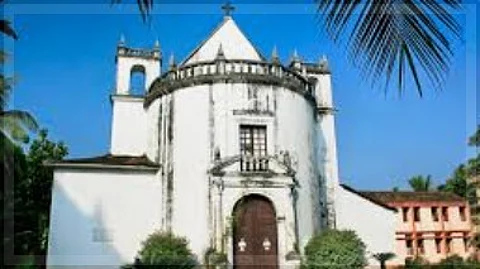

The St Anthony Royal Chapel, situated in Old Goa, is found in Velha Goa, approximately 800 meters from the Sé Cathedral, near the ruins of the Convent of St. Augustine.
The modest chapel features an eastern façade and is positioned on the southern side of the Igreja de Nossa Senhora do Rosário, constructed concurrently with it. During the reconquest of Goa, Diogo Mendes de Vasconcelos was stationed here with a contingent of 300 men. Commonly referred to as the Royal Chapel, it was initially managed by the Cathedral Chapter until Archbishop Dom Aleixo de Menezes transferred its administration to the Augustinians in 1606. Following the dissolution of religious orders, the chapel fell into disuse. The first Patriarch of Goa later restored it in honor of the seventh centenary of St Anthony, placing it under the oversight of the administrator of the convent of St Francis of Assisi.
The Chapel features a vaulted chancel, with a retable of St Anthony embellishing the main altar. The side altars are dedicated to Our Lady of Fever and Saints Cosimo and Damian. Four frescoes depicting the five doctors of the Church adorn the walls of the Chapel. The artwork of Our Lady of Fever includes a poignant two-verse poem that addresses the theme of 'Spiritual fever,' which the poet considers to be more perilous. He implores Our Lady to restore his spiritual well-being.
DID YOU KNOW THAT The history of this Chapel is intertwined with queer traditions?
St. Anthony was esteemed as the patron saint of military forces and served as their Captain. Consequently, the Chaplain received a salary for St. Anthony in addition to his own remuneration. Annually, during the Vespers of his feast, St. Anthony's image was paraded to the Public Treasury, where the treasurer would ceremoniously present his payment for the title of captain. However, in 1838, Governor Barão de Sabroso deemed this payment unnecessary and discontinued it.
The populace expressed their dissent, asserting that the Saint would exact retribution upon him. Indeed, on October 14, while the Governor was taking his customary stroll on the feast day of St. Anthony, he fell from his carriage and succumbed to his injuries. Prior to his demise, he had stepped down from his position, and on September 28, the Conselho do Governo reinstated the payment to St. Anthony. In a similar vein, when the Viscount of Vila Nova de Ourem sought to eliminate the traditional celebration on June 13, the feast day of the Saint, he experienced a fall from his horse. He interpreted this incident as a divine warning from the Saint, prompting him to reconsider his decision. Although Caetano de Albuquerque did abolish the holiday, it was said that he escaped the Saint's punishment, as the new Viscount of Paço de Arcos, Dom Carlos Eugénio Correia da Silva subsequently reinstated the holiday.